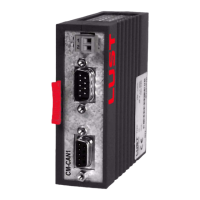1-4
User Manual CM-CAN1
1 General introduction
1.5 General infor-
mation on the
structure of a
CAN network
Multimaster capability
A CAN network has multimaster capability - that is, any station can
independently send messages on the bus which can be received by any
other station on the bus.
Figure 1.1 Any station can independently send messages.
Typically, however, transmissions are exchanged between two stations on
the bus.
The basic rule is: Anyone can evaluate the information from an identifier,
but only one station per identifier can have transmission rights .
Each transmission is assigned a priority by the selection of the identifier
for that transmission. The priority is antiproportional to the identifier num-
ber - that is, a rise in the significance of the identifier results in fall in the
priority of the transmission. Monitoring of the priorities and the issue of
access rights to the bus is controlled on the hardware side by the CAN
controller.
Note: To operate drive controllers in a network there must be no
overlaps between the identifiers used.
1.5.1 Access rights
Access rights to the bus where a number of stations are accessing it
simultaneously are assigned by checking the priorities of the identifiers.
The identifier with the lowest significance has the highest priority, and is
able to continue its transmission in the event of a conflict.
Master
Master
Master
Master

